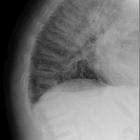superscan

Superscan •
Diffuse bone metastases - prostate cancer - Ganzer Fall bei Radiopaedia

Superscan •
Superscan due to metastatic prostate cancer - Ganzer Fall bei Radiopaedia

Superscan •
Superscan - Ganzer Fall bei Radiopaedia

Hyperparathyroidism
• Renal osteodystrophy - metabolic superscan - Ganzer Fall bei Radiopaedia

Superscan •
Superscan - metastatic bone disease - Ganzer Fall bei Radiopaedia

Superscan •
Metastatic prostate cancer - superscan - Ganzer Fall bei Radiopaedia

Superscan •
Prostate cancer skeletal metastases - superscan - Ganzer Fall bei Radiopaedia

Superscan •
Superscan - prostate cancer skeletal metastases - Ganzer Fall bei Radiopaedia

Primary
myelofibrosis: spectrum of imaging features and disease-related complications. 99mTc Tc-99 m isotope HDP nuclear bone scan in a different patient demonstrates an appearance approaching a ‘superscan’ appearance due to intense skeletal tracer distribution. This case also provides a clue to the cause of skeletal uptake: note that the left kidney has been displaced inferiorly by an enlarged spleen from marked splenomegaly (black arrow). 99mTc-99 m nuclear bone scans may be helpful in identifying marrow presence in extramedullary sites of haematopoiesis
Superscan is intense symmetric activity in the bones with diminished renal and soft tissue activity on a Tc diphosphonate bone scan.
Pathology
This appearance can result from a range of etiological factors:
- diffuse metastatic disease
- prostatic carcinoma
- breast cancer
- transitional cell carcinoma (TCC)
- multiple myeloma (some difference in opinion)
- lymphoma
- patchy uptake nonetheless: look at skull and ribs
- tends to somewhat spare the distal skeleton
- metabolic bone diseases
- renal osteodystrophy
- hyperparathyroidism (often secondary hyperparathyroidism)
- osteomalacia
- will involve distal skeleton
- smoother uptake
- myelofibrosis/myelosclerosis
- mastocytosis
- wide spread Paget disease
Radiographic appearance
A metastatic superscan tends to have uptake throughout the axial skeleton and proximal appendicular skeleton, often somewhat heterogeneous. In contrast, a metabolic superscan tends to be more uniform and involve both the axial and more peripheral skeleton, including the distal extremities, calvarium, and mandible.
See also
Siehe auch:
- Morbus Paget des Knochens
- primärer Hyperparathyreoidismus
- Osteomyelofibrose
- Multiples Myelom
- Renale Osteodystrophie
- Adenokarzinom der Prostata
- Osteomalazie
- Mastozytose
- Urothelkarzinom
- Skelettszintigraphie
- Neoplasien der Mamma
und weiter:

 Assoziationen und Differentialdiagnosen zu Superscan Szintigraphie:
Assoziationen und Differentialdiagnosen zu Superscan Szintigraphie:










